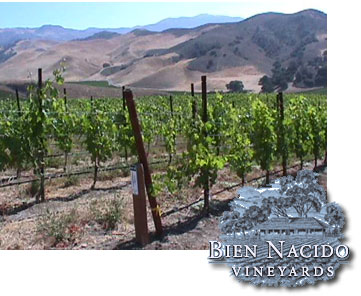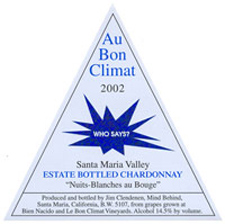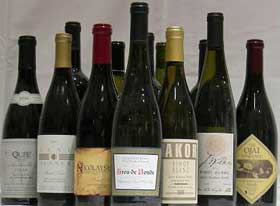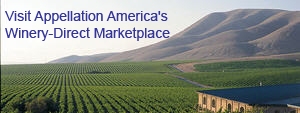

Editor-at-Large Dan Berger traces the history and success of a one-of-a-kind vineyard.
My, has the Bien Nacido Vineyard come a long way in three decades.
Tepusquet [Bien Nacido Vineyard] soon was seen as a resource from which to offer not only a Chardonnay of true style and nuance (some said the wines approached a Burgundian lilt), but also a cool enough climate to wrest from it distinctive Pinot Noir and Syrah.
by
Dan Berger
April 3, 2007
The idea was economically sound: plant a vineyard that would basically cost very little because the tax incentives to do so were worth it. The idea appealed mainly to large corporations seeking a tax shelter.
Acquired by the Miller family in 1969, one large property near Santa Maria in Santa Barbara County was not yet a vineyard, but since corporate plantings were apace, the Millers saw the potential for their land to produce grapes for top-flight wines.
At the time, in the early 1970s, when this vineyard was going in, little was known about what grapes it would support. This was well before scientific studies of the 1980s and 1990s would become the refining elements for a property that had an all-but-unpronounceable name: Tepusquet, named for a creek which ran through the property.
Tepusquet (pronounced tep-us-kay) was quickly re-named by the Millers as Bien Nacido Vineyards of Rancho Tepusquet. Local legend has it that the latter word means “fishing for trout” in the Chumash Indian language.
Soon after the first grapes were harvested from the Bien Nacido property, it was clear that the resulting wine would help to redefine the character of California Chardonnay as we knew it. Until then, the most important style of Chardonnay was being made 400 miles to the north.
In the 1970s, the vast majority of California Chardonnays came from warmer areas such as Napa Valley or Sonoma County; little of it came from the cooler Carneros, then still a fledging growing region. Napa Chardonnay came from Mount Veeder, the Rutherford floor, the plains south of Yountville (now Oak Knoll), and other relatively warm regions. Sonoma Chardonnay came from Sonoma Valley and the distinctively warmer Alexander Valley.
Meanwhile, during those early years, Tepusquet was proving to be a temperamental child, with occasional ornery fits of under-ripeness causing some of the Chardonnay fruit to deliver a minty note amid its minerality and citrus-tropicality.

Au Bon Climat winemaker, Jim Clendenen, was among the early adopters of the high quality cool-climate fruit from Bien Nacido.
The early kindergarten teachers tamed the beast with adventuresome forays into trellising experiments, and with radical tactics in the winery to craft a wine that was tamer and less cantankerous. Without getting too bogged down in detail, Tepusquet soon was seen (mainly by locals) as a resource from which to offer not only a Chardonnay of true style and nuance (some said the wines approached a Burgundian lilt), but also a cool enough climate to wrest from it distinctive Pinot Noir and Syrah.
Among the heroes of the early years and later, after the vineyard’s re-naming to Bien Nacido, are Jim Clendenen of Au Bon Climat; Ken Brown of Zaca Mesa, then Bryon, and now his own eponymous label; Adam Tolmach of Ojai Vineyard, and Bob Lindquist of Qupé.
The cool marine influence here dictated that the Bordeaux varieties be pulled out. So they were. And the marketplace (which was utterly remiss) turned its back on some of the state’s finest Riesling. So it, too, was soon lost. And Sauvignon Blanc was seen as too vegetative here. But curiously, Pinot Blanc did so well in this soil and clime that it remained as a player, and the big three of Chardonnay, Pinot Noir, and Syrah soon were joined by smaller plantings of other cool-hardy varieties.
The curious thing about Tepusquet/Bien Nacido is that despite the vineyard name appearing on many wine labels, and despite the fact that wine makers up and down the coast have swooned when promised some of its fruit, the vast vineyard seems never to have gained the public recognition for its greatness.
Oh, it’s true that Lindquist of Qupé long has made a stellar Syrah from Bien Nacido, and it was his technical paper on cool-climate Syrah that got many other cool-region vineyard owners to consider planting the variety. Still, few wine buyers outside this region understood the value of the Bien Nacido name on the label.
Locally, of course, that’s not true. Wine lovers who live between San Jose and Los Angeles, and most notably those who live in Santa Barbara, pay strict attention to the vineyard’s name, recognizing a style of wine that is anything but mainstream.
The acidity here produces a brightness in all wines, and the slow development of flavors can mean a distinctive wine, white or red. The Chardonnay notably often delivers a ripe apple and tropical fruit note along with a “pumpkin squash” element, but the racy citrus-y notes of the wines usually are what make them work with seafood.
The Pinots can be a tad on the leafy and/or rustic side, but all that does is push them half way to Burgundy, giving them an age-worthiness rare in warmer climes. And the Syrahs are nothing like the brutes which populate warmer regions like Paso Robles, Napa, or Alexander Valley.

In collaboration with several winemakers, Bien Naci
Acquired by the Miller family in 1969, one large property near Santa Maria in Santa Barbara County was not yet a vineyard, but since corporate plantings were apace, the Millers saw the potential for their land to produce grapes for top-flight wines.
At the time, in the early 1970s, when this vineyard was going in, little was known about what grapes it would support. This was well before scientific studies of the 1980s and 1990s would become the refining elements for a property that had an all-but-unpronounceable name: Tepusquet, named for a creek which ran through the property.
Tepusquet (pronounced tep-us-kay) was quickly re-named by the Millers as Bien Nacido Vineyards of Rancho Tepusquet. Local legend has it that the latter word means “fishing for trout” in the Chumash Indian language.
Soon after the first grapes were harvested from the Bien Nacido property, it was clear that the resulting wine would help to redefine the character of California Chardonnay as we knew it. Until then, the most important style of Chardonnay was being made 400 miles to the north.
In the 1970s, the vast majority of California Chardonnays came from warmer areas such as Napa Valley or Sonoma County; little of it came from the cooler Carneros, then still a fledging growing region. Napa Chardonnay came from Mount Veeder, the Rutherford floor, the plains south of Yountville (now Oak Knoll), and other relatively warm regions. Sonoma Chardonnay came from Sonoma Valley and the distinctively warmer Alexander Valley.
The Halcyon Days of No Malolactic Chardonnay
It was a time when most Chardonnays did not go through malolactic fermentations. Indeed, the dean of California wine makers at the time, and perhaps the greatest wine maker in the state’s history, Andre Tchelistcheff at Beaulieu Vineyard, never put a Chardonnay through malolactic, believing it robbed the warm-climate Chardonnay fruit of its heart and soul – its acidity. Nor did the Chateau St. Jean “Robert Young Vineyard” Chardonnay undergo malolactic.Meanwhile, during those early years, Tepusquet was proving to be a temperamental child, with occasional ornery fits of under-ripeness causing some of the Chardonnay fruit to deliver a minty note amid its minerality and citrus-tropicality.

Au Bon Climat winemaker, Jim Clendenen, was among the early adopters of the high quality cool-climate fruit from Bien Nacido.
Among the heroes of the early years and later, after the vineyard’s re-naming to Bien Nacido, are Jim Clendenen of Au Bon Climat; Ken Brown of Zaca Mesa, then Bryon, and now his own eponymous label; Adam Tolmach of Ojai Vineyard, and Bob Lindquist of Qupé.
The cool marine influence here dictated that the Bordeaux varieties be pulled out. So they were. And the marketplace (which was utterly remiss) turned its back on some of the state’s finest Riesling. So it, too, was soon lost. And Sauvignon Blanc was seen as too vegetative here. But curiously, Pinot Blanc did so well in this soil and clime that it remained as a player, and the big three of Chardonnay, Pinot Noir, and Syrah soon were joined by smaller plantings of other cool-hardy varieties.
Visionaries from the North See Bien Nacido’s Magic
Santa Barbara County has many locales in which to grow sensational fruit for those wines. But it was here, adjacent to Bien Nacido, that two of the visionaries saw the need to control their own destinies in this area of Santa Maria Valley. Jess Jackson and Robert Mondavi, in the late 1980s, linked hands for a brief and rare joint vineyard purchase, splitting the properties along mystical lines. Today, both have significant acreage nearby.A small side note: so important was this area of the county that mighty Beringer, the huge winery in Napa then owned by Nestlé, was just seconds short of short-circuiting the Kendall-Jackson/Mondavi land deal, and taking huge parcels of land here for itself. Later, it did acquire a lot of land hereabouts anyway.
The curious thing about Tepusquet/Bien Nacido is that despite the vineyard name appearing on many wine labels, and despite the fact that wine makers up and down the coast have swooned when promised some of its fruit, the vast vineyard seems never to have gained the public recognition for its greatness.
Oh, it’s true that Lindquist of Qupé long has made a stellar Syrah from Bien Nacido, and it was his technical paper on cool-climate Syrah that got many other cool-region vineyard owners to consider planting the variety. Still, few wine buyers outside this region understood the value of the Bien Nacido name on the label.
Locally, of course, that’s not true. Wine lovers who live between San Jose and Los Angeles, and most notably those who live in Santa Barbara, pay strict attention to the vineyard’s name, recognizing a style of wine that is anything but mainstream.
The acidity here produces a brightness in all wines, and the slow development of flavors can mean a distinctive wine, white or red. The Chardonnay notably often delivers a ripe apple and tropical fruit note along with a “pumpkin squash” element, but the racy citrus-y notes of the wines usually are what make them work with seafood.
The Pinots can be a tad on the leafy and/or rustic side, but all that does is push them half way to Burgundy, giving them an age-worthiness rare in warmer climes. And the Syrahs are nothing like the brutes which populate warmer regions like Paso Robles, Napa, or Alexander Valley.

In collaboration with several winemakers, Bien Naci



